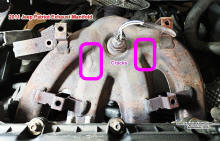
Cracks in 2011 Jeep Patriot 2.4L exhaust manifold / catalytic converter
assembly.
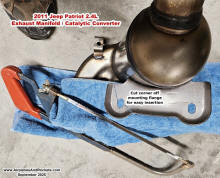
Corner cut from exhaust manifold mounting bracket to enable it
to be easily inserted.
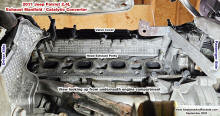
Engine head with exhaust manifold removed.
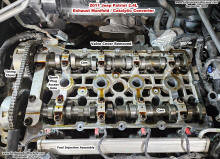
Valve cover removed for clearance of exhaust manifold.

Underside of valve cover.
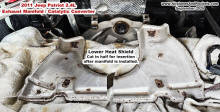
Lower heat shield cut in half for easy installation.
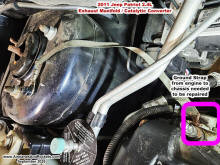
Ground strap between engine and chassis needed repair.
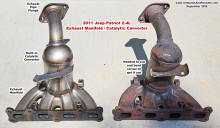
New (left) and old (right) exhaust
manifold / catalytic converter assembly for 2011 Jeep Patriot 2.4L engine.
I have the great misfortune of being a 2011 Jeep Patriot owner with the welded
steel combination exhaust manifold and catalytic converter that forms heat stress
cracks (see photo to the right), resulting in loud noise levels in the passenger cabin. Whilst out driving
one day recently, I noticed the sound level increased significantly, but not at
all speeds. After a lot of testing and researching on the Internet, I concluded
it had to be either a bad muffler, a loose baffle in the catalytic converter, or
a crack in the exhaust manifold. It sure sounded like it was coming from the engine
area, but I figured at 102,000 miles, it wouldn't hurt to try replacing the muffler
first. No such luck. I had a new muffler and the same old noise.
Upon removing the upper heat shield from the exhaust manifold, I could immediately
see two crack lines in the steel. I could not see the bottom (it turns out there
are no cracks there). After reading about what a nightmare replacing the exhaust
manifold / catalytic converter assembly is, I tried smearing some high temperature
manifold patch goop onto it. A few holes were drilled and tapped for 8-32 size bolts,
which were inserted to give the goop some gripping surface, but again, no dice.
The choice was to either put up with the noise (and possible exhaust fumes in the
passenger compartment), or replace the manifold.
The car parts stores (AutoZone, NAPA, etc.) want anywhere from $700 to $1,200
for replacements, but Amazon had some knock-offs available for under $200. I figured
if it keeps the beast running for a few more years before trashing it, then OK.
Customer reviews for all the ones I looked at cited instances of holes not
aligning properly. There were also horror stories of bolts breaking off in the engine
head while attempting to remove the bolts. Before shelling out moola for any price
manifold, I first verified that i could break all seven bolts loose without wringing
any off. So far, so good.
The next hurdle was getting the exhaust manifold / catalytic converter assembly
out of the ridiculously cramped area between the engine and the firewall. Again,
horror stories abound of contortions and manipulations required. Being one who enjoys
a challenge - especially with mechanical stuff - I accepted. Ten hours and a lot
of grief later, everything is back together and seems to be running well.
I won't repeat what many other people have already posted about the experience,
but will point out a couple of things I did to make the process a tad bit easier.
Most posts I found said it would be necessary to both remove the valve cover
and lower one side of the engine by removing part of the engine mount. The valve
cover didn't seem like it would be too bad, but I really didn't want to do the engine
mount.
I did take off the valve cover - a very simple process with only a few electrical
and pneumatic connections and a fuel line disconnection required. Fortunately, the
valve cover gasket is pliable rubber that comes off and goes back on very easily
- no need to replace it. A towel was laid over the internals to protect everything
and to keep gunk from dropping in.
Removing the manifold assembly requires rotating it 180° from top to bottom
and 180° left to right - outrageous! It almost came out, but not quite. One of the
lower mounting bracket corners was hitting the head, and there was absolutely no
way to finagle it out. Determined not to remove the engine mount, I took a hacksaw
and cut off the offending corner. Before attempting to install the new manifold,
I made the same cut - plus a little extra for good measure. It cut out one of the
lower mounting bracket holes, but I just put a big washer under the bolt head to
sufficiently capture the bracket. It still took the skill of a contortionist to
wiggle it back in, but doing so was not too awful.
All but two of the mounting holes lined up perfectly, and of course those two
were the most difficult to access (inner holes on the bottom). I am ashamed to admit
it, but since there was no way I was going to take it out and file those holes,
I ended up grinding tapers on the ends of the bolts and having to put a 3/8" stack
of washers under the heads to be able to cinch them nice and tight against the head
mating flange. Again, it just has to last a couple more years.
One more thing... The lower heat shield is supposed to be slipped into place
between the engine and the catalytic converter before installation, because there
is no way to get it in afterward. Knowing it would be nearly impossible to get the
head mounting flange bolts in with that blasted thing in the way, i decided to just
cut it in half (see photo) and install it after the exhaust manifold / catalytic
convers assembly was on. It seems to be fine.
Oh yeah, and I noticed the ground strap between the engine block and chassis
was nearly eaten through with corrosion, so I took it apart and repaired it. There's
no telling what kind of quirky electrical problems could be caused with that connection
broken.
In just 102,000 miles I have replaced all the brakes and rotors, the driver-side
CV axel, both lower tie rod ends, the muffler (not really necessary), and something
else that escapes me at the moment. The car is kept inside a garage and is meticulously
maintained and cleaned. In just shy of 14 years it has averaged only about 7,200
miles per year - way below average. Most of those miles were spent making a couple
treks each year between our home in Erie, Pennsylvania, and our daughter's home
in Greensboro, North Carolina. Jeep should be highly embarrassed.
|



